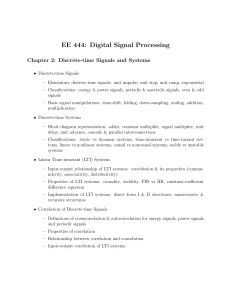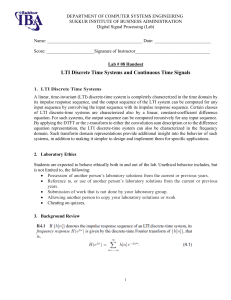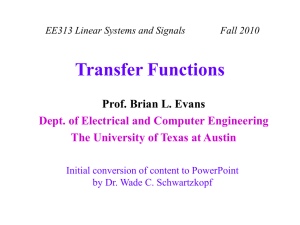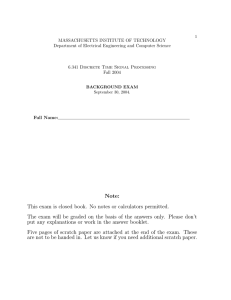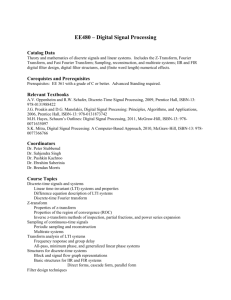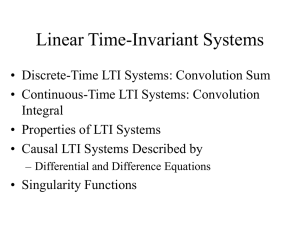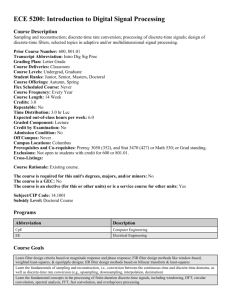Frequency Response of Discrete
advertisement
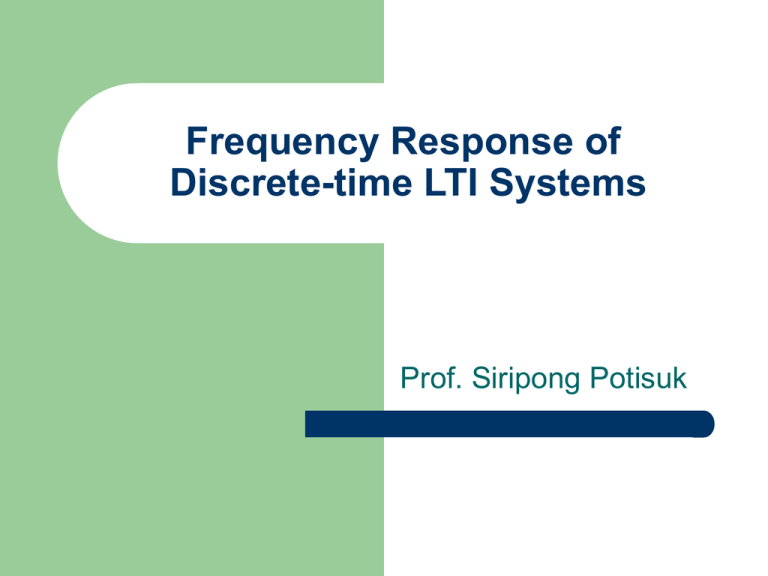
Frequency Response of
Discrete-time LTI Systems
Prof. Siripong Potisuk
Transfer Functions
Let x[n] be a nonzero input to an LTI discrete-time system, and
y[n] be the resulting output assuming a zero initial condition.
The transfer function, denoted by H(z), is defined:
Z{ y[n]} Y ( z )
H ( z)
Z{ x[n]} X ( z )
Can be determined by taking the Z-transform of the governing
LCCDE and applying the delay property
N
M
Z a0 y[n] ak y[n k ] bk x[n k ]
k 1
k 0
Y ( z ) b0 b1 z 1 bM z M
H ( z)
X ( z ) a0 a1 z 1 a N z N
The system’s impulse response: h[n] Z 1 H ( z)
BIBO Stability
• BIBO = Bounded-input-bounded-output
• A linear time-invariant (LTI) discrete-time
system with transfer function H(z) is BIBO
stable if and only if the poles of H(z) satisfy
| pi | 1,
1 i N
• That is, the poles of a stable system, whether
simple or multiple, must all lie strictly within
the unit circle in the complex z-plane
the unit circle
• Marginally unstable one or more simple
Ex. Consider a 2nd order discrete-time LTI system with
y[n] 1.2 y[n 1] 0.32y[n 2] 10x[n 1] 6 x[n 2]
(a) Determine the transfer function of the system and
comment on the stability of the system.
(b) Determine the zero-state response due to a unit-step
input and the DC gain of the system.
Frequency Response
For a discrete-time LTI system, the frequency response
is defined as
j
Y
(
e
)
j
H (e )
X (e j )
In terms of transfer function,
j
H ( e ) H ( z ) z e j ,
The frequency response is just the transfer function
evaluated along the unit circle in the complex z-plane.
Im(z)
periodic in
with period 2
H(ej)
1
Re(z)
H (e j ) H (e j 2f ) H ( z ) z e j 2 f , 2 f
H ( F ) H (e
j 2FTs
Fs
Fs
) H ( z ) z e j 2 FT s , F
2
2
For H(z) generated by a difference eq. with real
coefficients,
Fs
H ( F ) H ( F ), 0 F
2
A( F ) | H ( F ) | (Evenfunction)
Im{H ( F )}
( F ) tan
(Odd function)
Re{H ( F )}
1
Ex. Consider a 2nd order discrete-time system with
z 1
H ( z) 2
z 0.64
Plot the magnitude and phase responses of the system.
Determine also the DC and the high-frequency gain.
Effects of Pole & Zero Locations
j1
• A zero at z z1 1e indicates that the filter
will fully reject spectral component of input at 1
• Effects of a zero located off the unit circle depends
on its distance from the unit circle.
• A zero at origin has no effect.
• A pole on the unit circle means infinite gain at that
frequency.
• The closer the poles to the unit circle, the higher the
magnitude response.
Ex. Roughly sketch the magnitude response of the
system with
z 2 ( z 1)
H ( z)
( z 0.89)(z 0.5 j 0.8)(z 0.5 j 0.8)
Ex. Roughly sketch the magnitude response of the
system with
0.05634(1 z 1 )(1 1.0166z 1 z 2 )
H ( z)
(1 0.683z 1 )(1 1.4461z 1 0.7957z 2 )
For a given choice of H(ej) as a function of , the
frequency composition of the output can be shaped:
- preferential amplification
- selective filtering of some frequencies
Ex. Consider a 1st order IIR digital filter with
0.5(1 c)( z 1)
H ( z)
z c
(a) Determine c such that the system is BIBO stable.
(b) Without plotting the magnitude response of the
system, determine the type of this filter.
(c) Verify the answer in (b) using MATLAB.
